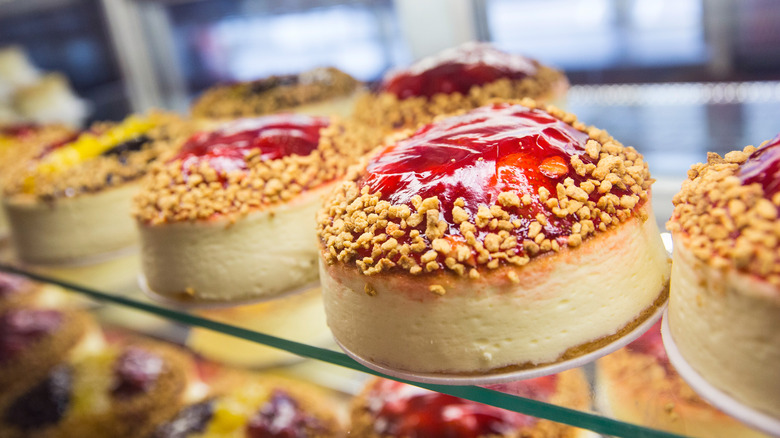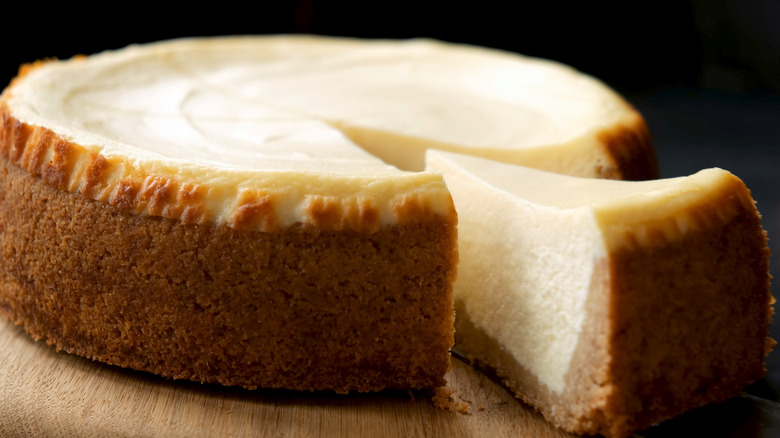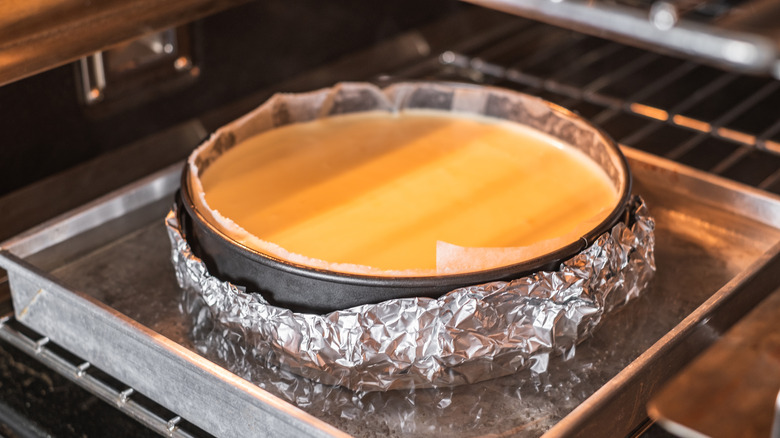Why You Should Use A Thermometer To Check If Your Cheesecake Is Done
Every decent cake recipe has a recommended baking time range, which usually spans anywhere from 25 to 60 minutes. When the timer goes off it's easy to figure out if the cake is done because you can insert a toothpick or cake tester to see if it comes out clean. A lot of bakers also test their cakes by lightly pressing two fingers down in the center of the cake to see if it springs back, which means that the crumb is set and the cake is cooked through. When it comes to a classic baked cheesecake, however, the usual visual tricks don't work because it's so thick and sticky even when it's baked. Cheesecake is really just a thick custard if you think about it, and it has a sweet spot for exactly when it needs to come out of the oven so that it's not over or undercooked. If you want to make sure you nail your cheesecake bakes every time, reach for your quick-read thermometer.
Baking with a timer might be a fond childhood memory, but using a thermometer is a bit less common. Professional pastry chefs keep a thermometer handy all the time, however, to check their bakes because it takes away a lot of guesswork.
Bake your cheesecake to this target temperature
Just like when you are trying to pull off the perfect prime rib, the only way to know if the interior of your cheesecake is cooked is to either take a temperature or cut it open. If you pull the cheesecake out too soon, it won't set, and your slices will fall apart. If you bake it too long, however, the edges will turn brown and the cake will crack. Since it's quite difficult to cut a hot cheesecake open, let your thermometer do the work. A cheesecake is fully cooked when the center reaches a temperature of 150 degrees Fahrenheit, but your goal is to take it out a little bit sooner.
The key to hitting the perfect cheesecake target is to pull your cheesecake out when it's five to 10 degrees shy of the target temperature. Most cheesecakes are baked in a water bath, also known as a bain marie, and there is a fair amount of carryover heat in the water and the pan that continues to cook the cake even after it comes out of the oven. If you pull it out at 150 degrees, it can overcook and crack.
Avoiding overbaking
While the "wiggle test" of shaking or tapping the pan might be an old-school baker favorite, you can still overbake your cheesecake while waiting for the jiggling to stop. As the custard of the cake continues to set after it's out of the oven, a perfectly baked cheesecake will actually still have a little bit of a wobble in its center when it's ready to come out of the oven. An overbaked cheesecake, on the other hand, will have a dry texture, and as it cools it will pull away from the sides of the pan and crack.
Cheesecake is not necessarily fussy, it's just very temperature-sensitive. If you want to catch your cheesecake at the right moment, right around 145 degrees, set the timer for three or four minutes less than what is recommended in the recipe, and check the temperature then. If it's not hot enough yet, stay close to the oven and check it again in four or five minutes, and pull it at 145 degrees. If you're worried about having a hole in your cake from the thermometer, don't stress; you can use the tip of a mini offset spatula to squish a little cake over the hole when it's still hot. The hole is also a good excuse for covering your slice with some fresh strawberries as a stunning cake decoration!


